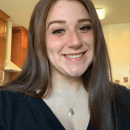I moved to Colorado because CU Boulder offered my major and actually had amazing undergrad and graduate programs. Speech, Language, and Hearing Sciences is a degree in which I’ll build a strong foundation in human communication, audiology, and speech-language pathology.
Now that I’ve been in the thick of it for over a year, I really feel like I know what to expect in different classes and what I should be looking for when I begin working in the field. Long term, my goal is to be a pediatric speech pathologist for special needs children. Short term, I plan on applying to at least fifteen different speech pathology master’s programs while earning my SLP-A certification and hopefully getting into my top-choice programs. For now, I’m still working my way through undergrad, but every day is different and busy! This is what my average Tuesday looks like.
9:00 AM
I am currently in the process of obtaining a Spanish minor in addition to my SLHS degree. In the case that I move back to California, the need for bilingual education and therapy is a great need, and I think it would be really cool to make an impact in my home state and especially in my home community. However, this is an in-person class that takes place every day, so it kind of wears on me, but I won’t reach my goals if I’m slacking!
10:30(ish) AM
Internships in the speech pathology field are few and far between, so imagine my surprise when I came across undergrad internship opportunities through the department and was offered a spot for both the ones I applied for! I ended up choosing the internship with Creative Strategies Therapy, a business that combines hippotherapy with speech therapy.
Hippotherapy is a treatment strategy that means “equine movement;” it affects the child’s system organization to create readiness for learning. The therapist uses the horse’s movement to promote variations in the child’s movement and increased sensory and postural organization. These changes provide natural prompts for communication skills, which is something that isn’t really taught in classes, but I feel so lucky to see it happen in person!
I see three kids on Tuesdays with the speech pathologist, Cathy. The first is a 3-year-old little boy who has apraxia of speech, a speech-sound disorder characterized by inconsistent speech sound errors on consonants and vowels, impaired prosody (rhythm of speech), and disrupted and/or lengthened coarticulatory transitions between sounds and syllables. Today, he did a great job of having a “ready body” (good posture) with very little cues, and the movement of the horse helped him answer questions like “Where are we going?” almost entirely through the movement alone with very little prompting from Cathy. He also had amazing progress with word-final stops (like /n/, /t/, /b/, /p/), and it was so cool to watch him as he listened to the song sung by Cathy and filled in the words correctly and with little prompting. His progress has arguably been the most obvious among the three kids I see during the day, but he is also the youngest, so maybe that’s why? We’ll keep repeating “pop” with him until he can do it all on his own!
11:35 AM
My next little boy is almost 4 years old. He has Asperger’s syndrome, which sometimes affects his speech through echolalia, which is the literal and rote repetition of his own and others’ speech. He was also born with a separated abdominal wall, so maintaining good posture on the horse is especially important for him. However, he is not treated for echolalia as it is not necessarily an issue with speech production; he is treated for a tongue thrust, a swallowing pattern that he has not grown out of that gives him a lisp on the /s/ sound.
Honestly, I did not know what the therapy technique for eliminating a lisp would look like, much less a tongue thrust, but it was simpler than I imagined! Cathy and I practice the /s/ sound with him by asking him to keep his mouth small and modeling ours to show him what a “small mouth” looks like. His progress has definitely been the quickest of the kids I see, and Cathy thinks he’s very close to not needing us anymore!
12:45 PM
My last child of the day is a sweet little girl who is almost 11 years old! She has sessions off the horse every other week, so I get to see a more typical speech therapy session with her on those days. She has low to moderate-functioning autism, meaning her social skills impact her speech skills. Because she is school-age, Cathy and I work with her on more syntactical (grammar) skills, like sentence structure and intonation.
I used to work with a little girl with low-functioning autism, and my limited knowledge of human communication at the time made me wonder if she would ever have any kind of “normalcy” in her life. This new little girl I work with reminds me so much of my dear little friend, and she gives me so much hope and comfort in the fact that all good things take time, and she will be a functioning human being and member of society.
2:00 PM
This is only my second class of the day, but at this point, I’ve been up since 7:30 AM and haven’t had a break since I opened my eyes. This class is called Anatomy, Physiology, and Science of Speech, and it is the only section for the entire undergraduate class, which should tell you how popular the major is. It is definitely my hardest class. There is so much to memorize, and my professor LOVES to cold call, which isn’t as big of a deal to me because she pretty much only calls on the people whose names she remembers (lol). I generally like the class, but it takes up a lot of time outside to prepare for quizzes and case studies. The textbook, which also happens to be written by my professor, is full of coloring pages for the phonatory system, cells and tissues, craniofacial nerves, and so many other illustrations, and coloring during class is actually kind of peaceful and I learn a lot while doing it.
I usually go to work at my tutoring job after that class, and then I get home around 7 PM, tired as hell. Even though I feel drained and pretty lazy after, I always feel like I am making substantial progress toward my goals. It’s a lot, but it’s so worth it! :)



